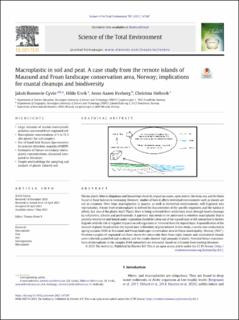| dc.description.abstract | Marine plastic litter is ubiquitous and knowledge about its impact on coasts, open waters, the deep-sea, and the biota found in those habitats is increasing. However, studies of how it affects terrestrial environments such as islands are not as common. Over time, macroplastics in marine, as well as terrestrial environments, will fragment into microplastics. A toxic level of microplastic is defined by characteristics of the specific organisms and the habitat it affects, but also of the plastic itself. Plastic litter is being collected from wilderness areas through beach-cleanups by volunteers, schools and professionals. A question that needs to be addressed is whether macroplastic that is partially weathered and buried under vegetation should be taken out of the topsoil layer or left untouched to further degrade with the risk of negative impacts on soil organisms or removed from the topsoil layer. A quantification of the amount of plastic found within the topsoil layer is therefore of great interest. In this study, a survey was conducted in spring/autumn 2020 at Mausund and Froan landscape conservation area in Frøya municipality, Norway (N63°). Thirteen samples of vegetated soil from above the storm tide limit from eight remote and uninhabited islands were collected, quantified and analyzed, and the results showed high amounts of plastic. Potential future concentrations of microplastic in the samples if left untouched are estimated, based on a formula from existing literature. | en_US |

